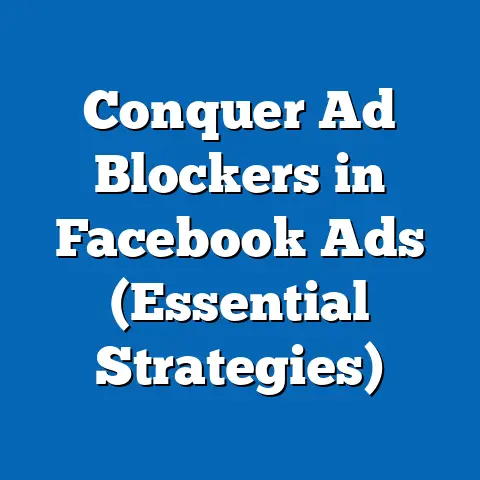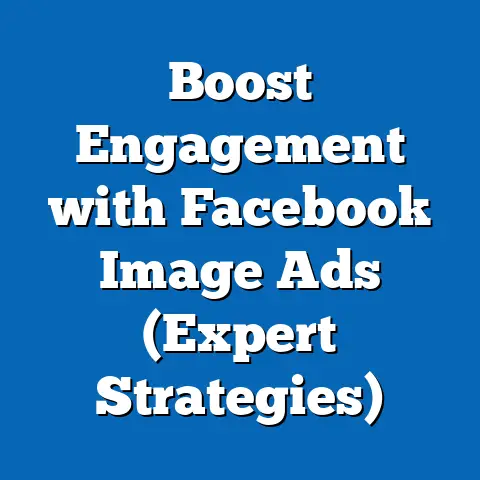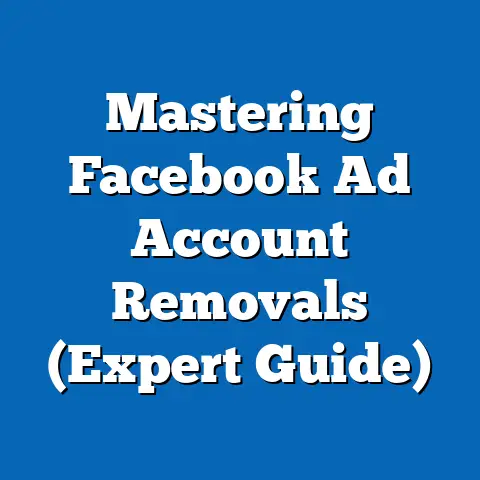Conquer Debt with Facebook Ads (Proven Strategies)
Meet Sarah. She’s not a real person, but she represents thousands of individuals out there. Sarah is a single mother juggling two part-time jobs, and every month, she feels like she’s drowning in debt. Credit card bills pile up, collection calls ring incessantly, and the anxiety of not knowing how to make ends meet is a constant companion. Just when she thinks she’s caught a break, an unexpected expense – a broken-down car, a sick child – sends her spiraling back into the abyss of financial despair. Sarah’s story, though fictional, is a stark reality for many. The overwhelming burden of debt is a crushing weight, leading to stress, sleepless nights, and a feeling of hopelessness. But what if there was a way to reach people like Sarah with solutions that could actually help? That’s where Facebook Ads come in. They offer a powerful, targeted approach to connect those seeking debt relief with the resources they desperately need.
Understanding the Power of Facebook Ads
Facebook isn’t just a social media platform; it’s a massive advertising ecosystem with unparalleled reach and targeting capabilities. I remember when I first started exploring Facebook Ads, I was blown away by the sheer volume of data available to advertisers. It felt like unlocking a treasure chest of potential customers.
The Reach of Facebook Ads
Facebook boasts billions of active users worldwide, making it a prime location to connect with a diverse audience. According to Meta’s latest reports, Facebook has over 3 billion monthly active users. That’s nearly half the world’s population! Within this vast network, you can pinpoint specific demographics, interests, and behaviors.
Think about it: if you’re offering debt relief services, you need to reach people who are actively searching for solutions. Facebook allows you to target individuals based on their income bracket, credit score interests (like personal finance or budgeting), and even life events (like job loss or divorce). I’ve seen firsthand how powerful this targeted reach can be. In one campaign I ran for a financial planning company, we were able to increase their lead generation by 40% simply by refining our Facebook audience targeting.
Here’s why Facebook’s reach is so important:
- Scale: Reach a massive audience with diverse backgrounds and financial situations.
- Targeting: Precisely identify and connect with individuals most likely to need debt relief services.
- Affordability: Start with a small budget and scale up as you see results.
Takeaway: Facebook’s massive user base and granular targeting options make it an ideal platform for reaching individuals struggling with debt.
Defining Your Target Audience
Reaching the right people is paramount. You can’t just blast your ads to everyone and hope for the best. That’s like throwing spaghetti at the wall and hoping something sticks. You need to be strategic.
The first step is to define your ideal customer. Who are they? What are their demographics? What are their pain points?
Here are some key demographics to consider when targeting individuals struggling with debt:
- Age: Are you targeting young adults burdened with student loans? Or older individuals struggling with medical debt?
- Income: What is their average income level? This will help you understand their ability to repay debt.
- Location: Are you targeting specific geographic areas with high debt rates?
- Education: What is their level of financial literacy? This will help you tailor your messaging.
- Life Events: Are you targeting individuals who have recently experienced a job loss, divorce, or other major life event that may have impacted their finances?
Once you have a good understanding of your target audience, you can create customer personas. A customer persona is a fictional representation of your ideal customer. It includes their demographics, psychographics, and buying behaviors.
For example, let’s create a customer persona for “Sarah,” the single mother I mentioned earlier:
- Name: Sarah
- Age: 35
- Occupation: Part-time retail worker, occasional freelance writer
- Income: $30,000 per year
- Location: Suburban area of a major city
- Family: Single mother with two children
- Pain Points: Overwhelmed by credit card debt, struggling to make ends meet, stressed about providing for her children, worried about her financial future.
By creating a detailed customer persona, you can better understand your target audience and tailor your ads to resonate with their specific needs and pain points.
Takeaway: Defining your target audience and creating customer personas are essential for crafting effective Facebook Ad campaigns that connect with individuals struggling with debt.
Proven Strategies for Running Effective Facebook Ads
Now that you understand the power of Facebook Ads and how to define your target audience, let’s dive into some proven strategies for running effective campaigns.
Crafting Compelling Ad Copy
Your ad copy is your opportunity to connect with your target audience on an emotional level. It’s your chance to show them that you understand their struggles and that you have a solution that can help.
Here are some tips for writing persuasive ad copy that resonates with individuals in debt:
- Empathize with their pain: Acknowledge the challenges they face and show them that you understand their struggles.
- Focus on the benefits, not the features: Highlight how your services can improve their lives, not just the technical details of your program.
- Use emotional triggers: Appeal to their hopes, fears, and desires.
- Create a sense of urgency: Encourage them to take action now.
- Use clear and concise language: Avoid jargon and technical terms.
- Include a strong call to action: Tell them exactly what you want them to do (e.g., “Get a free debt consultation,” “Learn more about debt relief options”).
Here’s an example of ad copy that incorporates these principles:
“Feeling overwhelmed by debt? You’re not alone. We understand the stress and anxiety that comes with owing money. Our proven debt relief program can help you regain control of your finances and achieve financial freedom. Get a free consultation today and take the first step towards a brighter future.”
I’ve found that using “you” language, directly addressing the reader, is incredibly effective. It makes them feel seen and understood.
Takeaway: Compelling ad copy is essential for connecting with individuals struggling with debt. Focus on empathy, benefits, and a strong call to action.
Eye-Catching Visuals
Visuals play a crucial role in capturing attention on Facebook. In a sea of posts and updates, your ad needs to stand out.
Here are some tips for using visuals effectively in your Facebook Ads:
- Use high-quality images or videos: Avoid blurry or pixelated images.
- Choose visuals that evoke emotion: Images of families overcoming financial hurdles, people smiling after achieving financial freedom, or infographics that demonstrate success stories can be very effective.
- Use contrasting colors: Make your ad stand out from the background.
- Keep it simple: Avoid cluttered or distracting visuals.
- Use text sparingly: Let the visuals do the talking.
For example, an image of a family happily paying off their mortgage could be a powerful visual for a debt relief ad. Or, a graph showing the reduction of debt over time could be an effective way to demonstrate the benefits of your services.
I once ran an ad campaign using a simple image of a person shredding credit cards, and it generated a surprisingly high click-through rate. The visual was simple, but it resonated with people who were tired of being trapped by debt.
Takeaway: Eye-catching visuals are essential for capturing attention on Facebook. Choose images or videos that evoke emotion and clearly communicate the benefits of your services.
Utilizing Video Content
Video content is incredibly engaging on Facebook. It allows you to tell a story, build trust, and connect with your target audience on a deeper level.
Here are some ideas for using video content in your Facebook Ads:
- Testimonials: Feature testimonials from people who have successfully conquered debt with the help of your services.
- Educational videos: Explain complex financial concepts in a simple and easy-to-understand way.
- Behind-the-scenes videos: Show the human side of your business and build trust with your audience.
- Live Q&A sessions: Answer questions about debt relief and provide valuable information to your audience.
When creating video content, keep the following tips in mind:
- Keep it short and sweet: Aim for videos that are under 60 seconds long.
- Grab attention in the first few seconds: Use a compelling hook to keep viewers engaged.
- Use captions: Many people watch videos with the sound off, so make sure your video is understandable without audio.
- Include a clear call to action: Tell viewers what you want them to do next.
I’ve found that video testimonials are particularly effective. Hearing real people share their success stories can be incredibly powerful and persuasive.
Takeaway: Video content is a highly engaging way to connect with your target audience on Facebook. Use testimonials, educational videos, and behind-the-scenes content to build trust and drive conversions.
Budgeting and Bidding Strategies
Setting the right budget and choosing the right bidding strategy are crucial for maximizing your ROI on Facebook Ads.
Setting an Effective Budget
Determining your advertising budget depends on several factors, including your goals, the competition in the debt relief niche, and your expected return on investment.
Here are some tips for setting an effective budget:
- Start small: Begin with a small budget and scale up as you see results.
- Set a daily or lifetime budget: Choose the option that best aligns with your campaign goals.
- Consider your target audience size: The larger your target audience, the larger your budget may need to be.
- Factor in your cost per acquisition (CPA): How much are you willing to spend to acquire a new customer?
- Monitor your results closely: Adjust your budget as needed based on your campaign performance.
I usually recommend starting with a daily budget of $10-$20 and gradually increasing it as you see positive results. It’s important to track your key metrics, such as CPA and return on ad spend (ROAS), to ensure that you’re getting a good return on your investment.
Takeaway: Setting an effective budget is crucial for maximizing your ROI on Facebook Ads. Start small, monitor your results closely, and adjust your budget as needed.
Bidding Strategies
Facebook Ads Manager offers several different bidding strategies, each with its own advantages and disadvantages.
Here are some of the most common bidding strategies:
- Cost-per-click (CPC): You pay each time someone clicks on your ad. This is a good option if your goal is to drive traffic to your website or landing page.
- Cost-per-impression (CPM): You pay for every 1,000 impressions your ad receives. This is a good option if your goal is to increase brand awareness.
- Cost-per-acquisition (CPA): You pay only when someone takes a specific action, such as filling out a form or making a purchase. This is a good option if your goal is to generate leads or sales.
For debt relief services, I typically recommend using CPC or CPA bidding. CPC is a good option if you want to drive traffic to a landing page where people can learn more about your services. CPA is a good option if you want to generate leads or sales directly from your ad.
Takeaway: Choosing the right bidding strategy is essential for achieving your campaign goals. Consider your objectives and test different bidding strategies to see what works best for your business.
Analyzing and Optimizing Ad Performance
Running a Facebook Ad campaign is not a “set it and forget it” activity. It requires ongoing monitoring and optimization to ensure that you’re getting the best possible results.
Key Metrics to Monitor
Here are some of the key metrics you should be monitoring to track your ad performance:
- Click-through rate (CTR): The percentage of people who see your ad and click on it. A high CTR indicates that your ad copy and visuals are resonating with your target audience.
- Conversion rate: The percentage of people who click on your ad and take a desired action, such as filling out a form or making a purchase. A high conversion rate indicates that your landing page is effective and that your offer is compelling.
- Cost per acquisition (CPA): The amount you spend to acquire a new customer. A low CPA indicates that your campaign is efficient and that you’re getting a good return on your investment.
- Return on ad spend (ROAS): The amount of revenue you generate for every dollar you spend on advertising. A high ROAS indicates that your campaign is profitable.
I recommend setting up a dashboard to track these metrics in real-time. This will allow you to quickly identify any issues and make adjustments as needed.
Takeaway: Monitoring key metrics is essential for understanding your ad performance and identifying areas for improvement.
A/B Testing for Continuous Improvement
A/B testing is a powerful tool for optimizing your Facebook Ad campaigns. It involves testing different versions of your ads to see which one performs best.
Here are some elements you can A/B test:
- Ad copy: Test different headlines, body text, and calls to action.
- Visuals: Test different images and videos.
- Targeting: Test different audiences and demographics.
- Bidding strategies: Test different bidding options.
- Landing pages: Test different landing page layouts and content.
For example, you could test two different headlines for your ad:
- Headline A: “Feeling Overwhelmed by Debt?”
- Headline B: “Take Control of Your Finances Today”
Run both ads simultaneously and track which one generates a higher CTR and conversion rate. The winning headline is the one that resonates most with your target audience.
I’ve seen firsthand how A/B testing can significantly improve campaign performance. In one campaign, we were able to increase our conversion rate by 50% simply by testing different ad headlines.
Takeaway: A/B testing is a powerful tool for optimizing your Facebook Ad campaigns. Test different elements to see what resonates most with your target audience and drive continuous improvement.
Real-Life Success Stories
Let’s take a look at a couple of real-life examples of how Facebook Ads have been used successfully in the debt relief niche.
Case Study 1: National Debt Relief
National Debt Relief is a leading provider of debt relief services in the United States. They have used Facebook Ads to generate leads and acquire new customers for many years.
Their strategy involves:
- Targeting: They target individuals with high credit card debt and low credit scores.
- Ad copy: Their ad copy focuses on the benefits of debt relief, such as reducing monthly payments and eliminating debt faster.
- Visuals: They use images of people smiling and feeling relieved.
- Landing pages: They use a dedicated landing page where people can learn more about their services and request a free consultation.
Their results:
- They have generated thousands of leads through Facebook Ads.
- They have significantly increased their customer base.
- They have achieved a positive return on ad spend.
Case Study 2: Accredited Debt Relief
Accredited Debt Relief is another leading provider of debt relief services. They have also used Facebook Ads to generate leads and acquire new customers.
Their strategy involves:
- Targeting: They target individuals who are struggling to keep up with their debt payments.
- Ad copy: Their ad copy focuses on the pain points of debt, such as stress, anxiety, and sleepless nights.
- Visuals: They use videos of people sharing their success stories.
- Landing pages: They use a quiz to help people determine if debt relief is right for them.
Their results:
- They have generated a high volume of qualified leads through Facebook Ads.
- They have significantly increased their brand awareness.
- They have achieved a positive return on ad spend.
These case studies demonstrate the power of Facebook Ads for generating leads and acquiring new customers in the debt relief niche.
Takeaway: Real-life success stories demonstrate the potential of Facebook Ads for generating leads and acquiring new customers in the debt relief niche.
Ethical Considerations in Advertising Debt Relief Services
Advertising debt relief services comes with a significant responsibility. It’s crucial to operate ethically and transparently.
Transparency and Honesty
It’s essential to be upfront about the potential risks and benefits of your services. Avoid making misleading claims or promising unrealistic results.
Here are some ethical guidelines to follow:
- Be clear about the fees and costs associated with your services.
- Explain the potential impact on credit scores.
- Disclose any potential risks or drawbacks.
- Avoid making guarantees or promises that you can’t keep.
I always advise my clients to err on the side of caution and be as transparent as possible with their advertising. Building trust with your audience is essential for long-term success.
Takeaway: Transparency and honesty are crucial for building trust with your audience and operating ethically in the debt relief niche.
Building Trust with Your Audience
Building trust with your audience is essential for long-term success. Here are some strategies to build trust:
- Share testimonials and reviews from satisfied customers.
- Provide clear and accurate information about your services.
- Be responsive to questions and concerns.
- Offer a money-back guarantee.
- Be transparent about your fees and costs.
I’ve found that featuring testimonials and reviews prominently on your website and landing pages is a great way to build trust with potential customers.
Takeaway: Building trust with your audience is essential for long-term success. Share testimonials, provide clear information, and be responsive to questions and concerns.
Conclusion: The Path to Financial Freedom
Facebook Ads offer a powerful tool for businesses in the debt relief niche to connect with individuals seeking financial freedom. By understanding the power of the platform, defining your target audience, crafting compelling ad copy, utilizing eye-catching visuals, and implementing effective budgeting and bidding strategies, you can create campaigns that drive results and make a real difference in people’s lives.
Remember, conquering debt is a challenging journey, but it is possible with the right resources and support. By operating ethically and transparently, you can build trust with your audience and help them achieve their financial goals.
So, take what you’ve learned in this guide and start implementing these strategies in your own Facebook Ad campaigns. With dedication, persistence, and a genuine desire to help others, you can make a positive impact on the lives of individuals struggling with debt and empower them to achieve financial stability.






